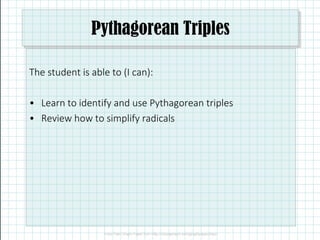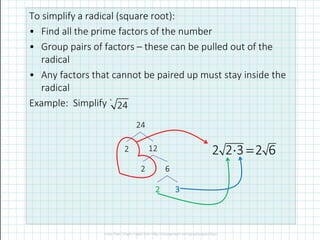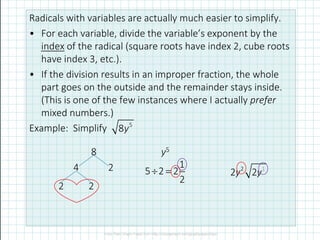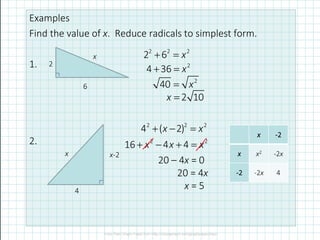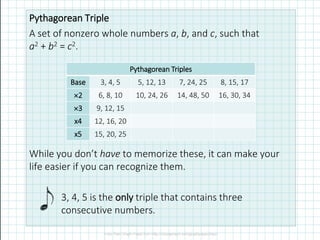7.2 Pythagorean Triples and Simplifying Radicals
- 1. Pythagorean Triples The student is able to (I can): ? Learn to identify and use Pythagorean triples ? Review how to simplify radicals
- 2. Square Roots ? When we are taking the square root of a number, we will not always get a whole number answer. ? If your answer is not a whole number, then the number your calculator gives you is a decimal approximation. This is an irrational number, like ?, which goes on forever. ? If I ask for an exact answer, I do not want a decimal ¨C I want you to leave it as a simplified radical.
- 3. To simplify a radical (square root): ? Find all the prime factors of the number ? Group pairs of factors ¨C these can be pulled out of the radical ? Any factors that cannot be paired up must stay inside the radical Example: Simplify ` 24 24 2 12 2 6 2 3 ? = 2 2 3 2 6
- 4. Radicals with variables are actually much easier to simplify. ? For each variable, divide the variable¡¯s exponent by the index of the radical (square roots have index 2, cube roots have index 3, etc.). ? If the division results in an improper fraction, the whole part goes on the outside and the remainder stays inside. (This is one of the few instances where I actually prefer mixed numbers.) Example: Simplify 5 8y 8 2 2 4 2 y5 1 5 2 2 2 ? = 2 1 2 2 y y
- 5. Examples Find the value of x. Reduce radicals to simplest form. 1. 2. 2 6 x x x-2 4
- 6. Examples Find the value of x. Reduce radicals to simplest form. 1. 2. 2 2 2 2 6 x + = 2 4 36 x + = 2 40 x = 2 10 x = 2 6 x x x-2 4
- 7. Examples Find the value of x. Reduce radicals to simplest form. 1. 2. 2 2 2 2 6 x + = 2 4 36 x + = 2 40 x = 2 10 x = 2 2 2 4 ( 2) x x + ? = 2 6 x x x-2 4
- 8. Examples Find the value of x. Reduce radicals to simplest form. 1. 2. 2 2 2 2 6 x + = 2 4 36 x + = 2 40 x = 2 10 x = 2 2 2 4 ( 2) x x + ? = x -2 x x2 -2x -2 -2x 4 2 2 16 4 4 x x x + ? + = 2 6 x x x-2 4
- 9. Examples Find the value of x. Reduce radicals to simplest form. 1. 2. 2 2 2 2 6 x + = 2 4 36 x + = 2 40 x = 2 10 x = 2 2 2 4 ( 2) x x + ? = x -2 x x2 -2x -2 -2x 4 2 2 16 4 4 x x x + ? + = 20 ¨C 4x = 0 20 = 4x x = 5 2 6 x x x-2 4
- 10. Pythagorean Triple A set of nonzero whole numbers a, b, and c, such that a2 + b2 = c2. Memorize these! While you don¡¯t have to memorize these, it can make your life easier if you can recognize them. 3, 4, 5 is the only triple that contains three consecutive numbers. Pythagorean Triples Base 3, 4, 5 5, 12, 13 7, 24, 25 8, 15, 17 ?2 6, 8, 10 10, 24, 26 14, 48, 50 16, 30, 34 ?3 9, 12, 15 x4 12, 16, 20 x5 15, 20, 25
- 11. Examples Find the missing side of the right triangle. 1. 3, 4, ____ 2. 9, ____, 15 3. ____, 12, 13 4. 8, 15, ____
- 12. Examples Find the missing side of the right triangle. 1. 3, 4, ____ 2. 9, ____, 15 (multiple of 3-4-5) 3. ____, 12, 13 4. 8, 15, ____ 5 12 5 17
